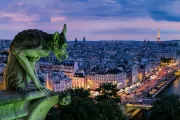Jul 7, 2011
The cathedrals of Chartres, Paris, Cologne, Florence, Siena and Toledo open their doors each day to thousands of pilgrims and tourists alike. They come to look, to gaze and to stand in wonder at these majestic marvels of architecture. Pugin, the famous British architect of the nineteenth century, once remarked that the Gothic style of these magnificent cathedrals was the only architectural and artistic style which Christianity created for itself.
At its birth, the Christian church simply worshipped in the houses of believers, most often those of its wealthier members. The very first followers of Jesus in Galilee assembled as church in St. Peter’s house in Capernaum along the shores of the Sea of Galilee. The Christians at Corinth met in the home of the wealthy business couple Aquila and Priscilla (cf. 1 Corinthians 16:19).
When the Emperor Constantine legalized Christianity in the 4th century, Christians began to build churches. They simply adopted existing architecture. They turned away from the temples of their pagan neighbors to their basilicas. The temples did not have the space necessary for congregations to gather and worship. But the basilicas did. The basilicas were used as courts of law and as meeting places. Rome’s St. Mary Major and St. John Lateran come from this earliest period of church architecture.
Over the centuries, Church architecture changed both in the East and the West. Gradually, the Orthodox Church introduced strict norms regarding sacred art. This process reached its high point in a 16th century council held in Moscow called “the Council of the Hundred Canons.” Even our Islamic neighbors have rather strict norms that make a mosque immediately recognizable anywhere in the world. Not so the Catholic Church.


